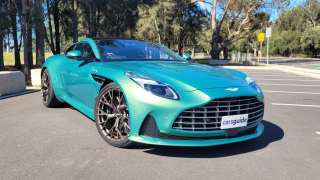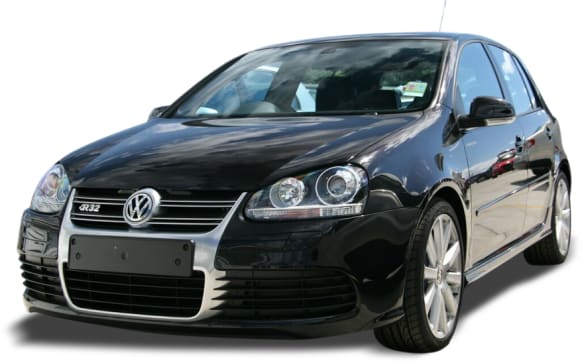
Volkswagen Golf VI 2009 Review
- Volkswagen Golf
- Volkswagen Golf 2009
- Volkswagen Golf Reviews
- Volkswagen Reviews
- Volkswagen Hatchback Range
- Hatchback
- Volkswagen
In a manner of speaking Volkswagen has, if not laid hands on, at least sighted the elusive target with its sixth generation of the Golf.
The little car that just keeps on keeping on with more than 26 million sales worldwide in a 35-year production run has come to market again, and this time with a pair of petrol engines that offer power increases of up to 23 per cent and efficiency improvements as high as 24 per cent alongside a fuel-sipping diesel with the latest common rail technology.
"More powerful engines that are more fuel efficient, safety that is going to be the benchmark in the class for some time to come - and all of that for all buyers from the entry car to the top model," says VW Australia boss Jutta Dierks.
"We took a very good Golf and made it better."
For the first time the Golf range in Australia will not have a naturally aspirated engine but rather three small, super efficient units with either turbo-induction or VW's brilliant "twin charger" technology which marries turbocharging and supercharging.
The three engines are coupled to either six-speed manual gearboxes or the optional DSG double-clutch automatics at an extra $2500.
It is no accident that the badge on the new Golf does not reflect the engine size as the prospect of boasting about a pair of 1.4-litre petrol units was not that appetising.
"If you are talking about putting numbers on badging, then 1.4 is not really that impressive - and it doesn't represent what the new engines offer," Dierks says.
Instead the badge now reflects the power output of the engines and while Dierks concedes that the use of TSI for both the turbo and twin-charger models could be confusing, at least initially, "it is a global decision".
TSI had previously been the designation for twin-charger models alone.
The entry-level 90TSI is a 1.4-litre turbocharged petrol model starting at $25,990 for the six-speed manual. However, if you don't want it in white - the only non-metallic colour available - then immediately add $700.
The 90kW engine replaces the naturally-aspirated 1.6-litre from the Golf V, lifting power by 15kW and carving 2.1L/100km off the fuel use.
For the 118TSI the improvements are just as dramatic with economy improved from 8.6L/100km in the previous 110kW 2.0-litre automatic to 6.5L/100km for the 7-speed DSG coupled to the new 1.4-litre.
For the first time VW will use common rail technology for its 2.0-litre turbocharged diesel in the 103TDI. According to VW the shift to common rail - in line with most of the diesel world - was driven by the third generation technology which allows for much higher pressure fuel delivery through the use of piezoelectric injectors with consequent reduction in compression ignition noise.
Power and torque are on a par with the previous unit injector (Pumpe Duse) system at 103kW and 320Nm but fuel efficiency has been cut from 6.1 to 5.6L/100km.
Apart from the engines and gearboxes the majority of change from the fifth to the sixth generation has been in subtle body shaping, small tweaks of the spring and damper rates and an upgrading of tactile surfaces within the cabin.
Keeping the genetic cues — which make the MkI Golf as unmistakably a member of the family as the MkV — was paramount to the design team for the new car.
"This is a `class free' car ... it is available to anyone, so much so that the small car category in Europe is known as the Golf Class," design team member Frank Bruese explained at the Australian launch of the Golf VI.
"Golf is about heritage and history and each generation must be easily identifiable as a Golf - it must have the Golf DNA of a strong horizontal face, distinct wheel arches and a strong C-pillar."
Beuse says that while the design changes are subtle rather than dramatic - sharper character lines, a new grille shape and restyled lights front and rear - as a unit they work to make the eye see a car that sits lower and looks more aggressive and sporty despite it having exactly the same major dimensions as the outgoing model.
"It is like an Armani suit," Beuse says. "It doesn't scream look at me but the closer you look the more you see of the quality of the material ... the class of the cut."
Under the dress suit the new Golf is sitting on almost all of the same running gear as the previous car. Apart from the tweaks to the spings and dampers - and the option of an active damper system on the top-spec Comfortline model - it is business as usual.
Styling inside the cabin is also readily recognisable as Golf although the quality of some of the touch surfaces - particularly the new steering wheel - and the inclusion of comfort items such as the climate control air-conditioning from the new Passat CC do lift the game.
Across the range seven airbags, electronic stability control, anti-lock brakes, electronic brakeforce distribution and traction control are all standard. The cars have also earned a five-star crash rating in both European and Australian testing.
Out on the road the Golf is quick to prove that it is going to keep its rivals honest - something that shouldn't be any surprise as it has been a hallmark of the previous two generations.
The ride is subtle and composed across the range with the diesel - on short association - appearing to be the best all-rounder.
Noise, vibration and harshness levels are good with only a degree of tyre roar on coarser-chip roads letting the side down.
Broken and uneven surfaces were generally soaked up without fuss, although the firmer sport setting of the optional adaptive suspension fitted to the 118TSI did fall victim to mid-corner bumps on a couple of occasions.
Both petrol engines can be punched along quite happily but it is the twin-charger 118TSI that excels when asked for extra effort. Despite being a slightly detuned version of the powerplant from the previous GT model it is a wonderfully realistic compromise between urban toodler and open road attack weapon.
If you didn't feel the need to spend the optional $1500 on the adaptive damping you really wouldn't be missing out on much.
Across the range the standard suspension is better than average with the general disposition of the cars balanced and composed.
Steering is typical of VW's front-drive cars with a comfortable degree of feedback, little tendency to be unsettled and consistent linear feel.
The new generation red-hot GTI, which has been a mainstay of Golf sales in Australia, is expected to arrive towards the end of this year. In the interim the current GTI will still be available.
VW Golf VI
Price: 90TSI $25,990, 118TSI $30,490, 103TDI $33,190 (add $2500 for DSG)
Engine: 1.4L/4-cylinder turbo 90kW/200Nm; 1.4L/4-cylinder twin-charger 118kW/240Nm; 2.0L/4-cylinder turbo-diesel 103kW/320Nm
Transmission: 6-speed manual, 7-speed DSG, 6-speed DSG (diesel)
Economy: 6.2L/100km (90TSI), 6.5L/100km (118TSI), 5.6L/100km (103TDI) - all combined cycle, all DSG.
Pricing guides
Range and Specs
| Vehicle | Specs | Price* | |
|---|---|---|---|
| 1.6 Edition | 1.6L, PULP, 5 SP MAN | $4,620 – 6,820 | 2009 Volkswagen Golf 2009 1.6 Edition Pricing and Specs |
| 1.9 TDI Edition | 1.9L, Diesel, 6 SP | $5,830 – 8,140 | 2009 Volkswagen Golf 2009 1.9 TDI Edition Pricing and Specs |
| 77 TDI Trendline | 1.6L, Diesel, 7 SP AUTO | $5,500 – 7,810 | 2009 Volkswagen Golf 2009 77 TDI Trendline Pricing and Specs |
| GT Sport TDI | 2.0L, Diesel, 6 SP MAN | $6,930 – 9,790 | 2009 Volkswagen Golf 2009 GT Sport TDI Pricing and Specs |
$3,490
Lowest price, based on 33 car listings in the last 6 months














